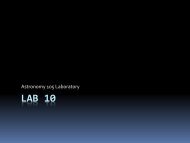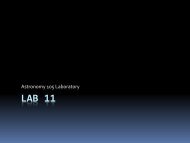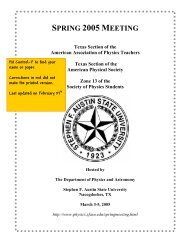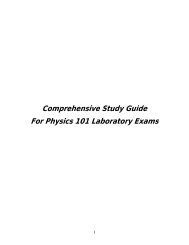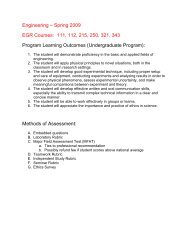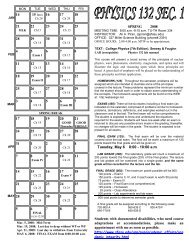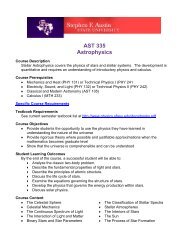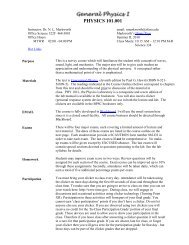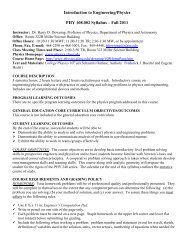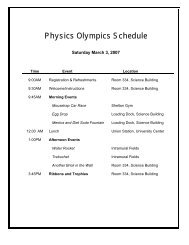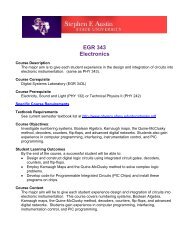[pdf] physics 110 fundamentals of electronics
[pdf] physics 110 fundamentals of electronics
[pdf] physics 110 fundamentals of electronics
You also want an ePaper? Increase the reach of your titles
YUMPU automatically turns print PDFs into web optimized ePapers that Google loves.
PHYSICS <strong>110</strong> FUNDAMENTALS OF ELECTRONICS<br />
FALL 2008<br />
Philip Blackburn, M.S.<br />
Office Hours:<br />
Room S-127F<br />
Mon. 11:00 - 12:00 AM<br />
468-3001 Thur. 1:30 - 3:00 PM<br />
I. Purpose<br />
The purpose <strong>of</strong> this course is to introduce the fundamental principles <strong>of</strong> <strong>electronics</strong>.<br />
Because <strong>electronics</strong> has become such an integral part <strong>of</strong> our lives, a basic understanding <strong>of</strong><br />
<strong>electronics</strong> has become a necessity.<br />
II.<br />
Materials<br />
The text for the course is Electronics Technology Fundamentals (Conventional Flow<br />
Version), Second Edition, by Paynter and Boydell. The material presented in class will be<br />
reinforced with a laboratory experience. The manual required for the laboratory is<br />
Laboratory Manual to Accompany Electronics Technology Fundamentals, Second Edition,<br />
by Paynter and Boydell. Although the material will be presented with an emphasis on<br />
practical applications, the theory portion <strong>of</strong> this course is somewhat mathematical and<br />
requires a working knowledge <strong>of</strong> high school algebra.<br />
III. Homework<br />
Homework problems will be assigned throughout the semester. The due dates will be<br />
announced in class and the homework will be due at the beginning <strong>of</strong> the class period on<br />
the due date. HOMEWORK WILL NOT BE ACCEPTED LATE. Each homework<br />
problem will be worth 10 points. Of those 10 points, only 1 point is for the answer. The<br />
remaining 9 points is for the work leading to the answer. The homework shall have the<br />
following form:<br />
1. A written statement <strong>of</strong> the problem. In other words, write the problem down<br />
verbatim as it appears in the text.<br />
2. A sketch that accompanies the problem.<br />
3. A clear and logical progression <strong>of</strong> work leading to the solution.<br />
If there are any doubts as to the form <strong>of</strong> the homework, then reference the many example<br />
problems in the text. The homework is very important because your homework average<br />
will carry the same weight as a major exam.
IV. Exams<br />
SEPT. 19 EXAM 1 Chapter 1: Principles <strong>of</strong> Electricity<br />
Chapter 2: Components and Circuit Measurements<br />
Chapter 3: Ohm's Law and Power<br />
Chapter 4: Series Circuits<br />
Chapter 5: Parallel Circuits<br />
Chapter 6: Series-Parallel Circuits<br />
Chapter 7: Circuit Analysis Techniques<br />
OCT. 13 EXAM 2 Chapter 9: Alternating Current and AC Measurements<br />
Chapter 10: Inductors<br />
Chapter 11: Resistive-Inductive (RL) Circuits<br />
Chapter 12: Capacitors<br />
Chapter 13: Resistive-Capacitive (RC) Circuits<br />
Chapter 14: RLC Circuits and Resonance<br />
NOV. 7 EXAM 3 Chapter 17: Introduction to Solid State Components: Diodes<br />
Chapter 18: Basic Diode Circuits<br />
Chapter 19: Bipolar Junction Transistor Operation and Biasing<br />
Chapter 20: BJT Amplifiers<br />
DEC. 10 FINAL Selected Topics:<br />
(Wed. 10:30 am - 12:30 pm) Op-Amp Circuits, 555 Timer Circuits, Power Supplies, Digital<br />
Logic Gates, and Digital Audio Recording<br />
V. Grading<br />
Your grade will be calculated using the following formula:<br />
Grade = .75<br />
⎛<br />
⎜<br />
⎝<br />
Exam 1 + Exam 2 +Exam 3 + Final +Hmewk Ave<br />
5<br />
where, A: 90-100, B: 80-89, C: 70-79, D: 60-69, and F: 0-59.<br />
⎞<br />
⎟ + .25 ( Lab Ave)<br />
,<br />
⎠<br />
Note that in accordance with the course description in the General Bulletin, the lecture part<br />
and the lab part go together to form a single grade. YOU WILL RECEIVE THE SAME<br />
GRADE IN BOTH THE LECTURE AND THE LAB BASED ON THE FORMULA<br />
ABOVE.
PHYSICS <strong>110</strong>L FUNDAMENTALS OF ELECTRONICS LAB<br />
FALL 2008<br />
Philip Blackburn, M.S.<br />
Office Hours:<br />
Room S-127F<br />
Mon. 11:00 - 12:00 AM<br />
468-3001 Thur. 1:30 - 3:00 PM<br />
I. Purpose<br />
The purpose <strong>of</strong> the lab is to reinforce the theory covered in the lecture part <strong>of</strong> this course<br />
with hands-on experience.<br />
II.<br />
Materials<br />
The manual required for the lab is Laboratory Manual to Accompany Electronics<br />
Technology Fundamentals, Second Edition, by Paynter and Boydell.<br />
III. Labs<br />
For the semester, there will be 11 regular labs and a final practicum. The final practicum is<br />
mandatory. Of the 11 regular labs, the 2 lowest grades will be dropped when computing<br />
the lab average. If you have any absences, either excused or unexcused, you will receive a<br />
grade <strong>of</strong> 0 for those labs and they will count towards your 2 drop grades. The lab schedule<br />
is as follows:<br />
LAB WEEK EXPERIMENTS<br />
1 Sept. 8 - Sept. 12 Exercise 3: Ohm's Law<br />
Exercise 5: Series Circuits and Kirchh<strong>of</strong>f's Voltage Law<br />
2 Sept. 15 - Sept. 19 Exercise 7: Parallel Circuits<br />
Exercise 9: Series-Parallel Circuits<br />
3 Sept. 22 - Sept. 26 Exercise 11: The Superposition Theorem<br />
Exercise 12: Thevenin's Theorem and Max. Power Transfer<br />
4 Sept. 29 - Oct. 3 Exercise 13: Inductors and Inductive Reactance<br />
Exercise 17: Capacitors and Capacitive Reactance<br />
5 Oct. 6 - Oct. 10 Exercise 15: Series RL Circuits<br />
Exercise 16: Parallel RL Circuits<br />
6 Oct. 13 - Oct. 17 Exercise 18: Series RC Circuits<br />
Exercise 19: Parallel RC Circuits<br />
7 Oct. 20 - Oct. 24 Exercise 20: Series LC Circuits<br />
Exercise 21: Parallel LC Circuits<br />
8 Oct. 27 - Oct. 31 Exercise 28: Diode Characteristics<br />
Exercise 29: Diode Rectifier Circuits<br />
9 Nov. 3 - Nov. 7 Exercise 33: The Common-Emitter Amplifier<br />
10 Nov. 10 - Nov. 14 Exercise 39: Inverting Amplifiers<br />
Exercise 40: Noninverting Amplifiers<br />
11 Nov. 17 - Nov. 21 Exercise 46: The 555 Timer<br />
Digital Logic Gates<br />
Final Nov. 24 - Nov. 28 Practicum over use <strong>of</strong> the lab equipment.
III. Grading<br />
Your grade in lab will count 25% <strong>of</strong> your course grade. Your course grade will be<br />
calculated using the following formula:<br />
Grade = .75<br />
⎛<br />
⎜<br />
⎝<br />
Exam 1 + Exam 2 +Exam 3 + Final +Hmewk Ave<br />
5<br />
where, A: 90-100, B: 80-89, C: 70-79, D: 60-69, and F: 0-59.<br />
⎞<br />
⎟ + .25 ( Lab Ave)<br />
,<br />
⎠<br />
Note that in accordance with the course description in the General Bulletin, the lecture part<br />
and the lab part go together to form a single grade. YOU WILL RECEIVE THE SAME<br />
GRADE IN BOTH THE LECTURE AND THE LAB BASED ON THE FORMULA<br />
ABOVE.


![[pdf] physics 110 fundamentals of electronics](https://img.yumpu.com/29312006/1/500x640/pdf-physics-110-fundamentals-of-electronics.jpg)

